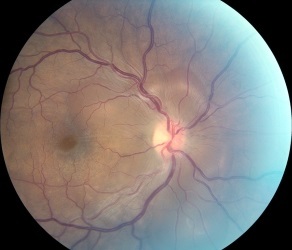
Nerve tissue is a kind of conductor between the brain and the senses.
Its damage leads to severe consequences. With them, modern medicine can not cope.
Therefore, of all eye diseases, those that affect the optic nerve are the most dangerous.
After all, the blindness caused by his death is irreversible, unlike blindness in cataracts or thorns.
Neuritis is one of the most common diseases of the optic nerve. It is this that provokes a large part of the episodes of a sharp drop in vision at a young age.
Next, we will detail the disease, how to deal with it and what preventive measures will help to avoid it.
- 1. What is it?
- 2. Causes of
- 3. Symptoms and Diagnosis
- 4. Treatment of
- 5. Preventive measures of
- 6. Forecast of
- 7. Conclusion of
- 8. Interesting video of
What is it?
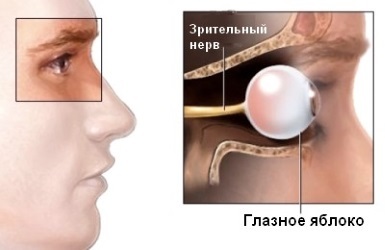
Inflammation, or optic neuritis, is a serious illness affecting nerve fibers. It affects both the tissue and the nerve shell.
In most cases, neuritis starts on one eye, and after a while, the second one is affected.
Species and types of the disease
The disease happens as chronic , when the inflammatory process proceeds slowly and the vision disappears gradually, and with acute - in this case, it takes a few days for the onset of complete blindness.
The disease is divided into two types:
- Simple neuritis. In this case, the disease affects only the disk, but does not pass to nearby tissues.
- Retrobulbar neuritis. This is a more common form of inflammation of the optic nerve, which affects not only the disc, but all the tissues next to it, as well as the nerve fibers behind the eyeball.
If you do not start treatment in time, neuritis can lead to complete incurable blindness.
History of the disease
Optic neuritis has been studied and described relatively recently when ophthalmology has reached a high level of development. In the twentieth century, the connection of this disease with multiple sclerosis and optoelectromuoelitis was derived.
As recent studies have shown, it is the inflammation of the optic nerve that becomes the first symptom of RAS in about half of people affected by this autoimmune pathology.
Risk Factors
People with chronic infectious diseases, with weak immunity and often having a cold, suffering from diabetes mellitus and other autoimmune diseases( especially RAS) who have a history of trauma to the skull, can be classified as a risk group.
Often inflammation of the optic nerve occurs in people with age.
Causes of
The development of optic neuritis itself is indicative of various disorders in the human nervous system.
Accurate and rapid diagnosis of possible pathologies will help to choose the right treatment tactics and quickly cope with inflammation. For the occurrence of this eye disease, there are a number of reasons:
- inflammation of the eye tissues, such as conjunctivitis, keratitis, iritis;
- various kinds of inflammatory processes occurring in the human brain, for example, meningitis;
- infectious diseases, both chronic and acute - chickenpox and black pox, syphilis, acute respiratory infections and ARVI, tonsillitis, tuberculosis;
- disorders of metabolic processes, such as diabetes mellitus of both types, anemia and other disorders of blood composition, as well as gout;
- craniocerebral injuries, even those that were transferred much earlier;
- ENT diseases;
- pregnancy;
- methylene poisoning;
- decreased immunity;
- multiple sclerosis and other demyelinating diseases.
Many factors, such as obesity associated with persistent vision stress work, are not the direct cause of the disease, but contribute to its development.
Symptoms and Diagnosis
Symptoms of the disease are extremely important for further diagnosis and diagnosis, it is they who rely on the specialist for further examination.
Symptoms of optic neuritis initially proceed secretly, disguised as eye strain or accommodation spasm, and begin to be more noticeable as the ailment develops.
This can happen in a short time with acute neuritis, or delay for months and years with chronic.
The first symptoms include redness of the nerve disc, which is noticeable only during ophthalmoscopy, and a decrease in the sharpness of the vision. As the inflammatory process increases, the vessels of the fundus widen, plasmorrhages and hemorrhages appear in the vitreous body.
Neuritis of the optic nerve is as follows:
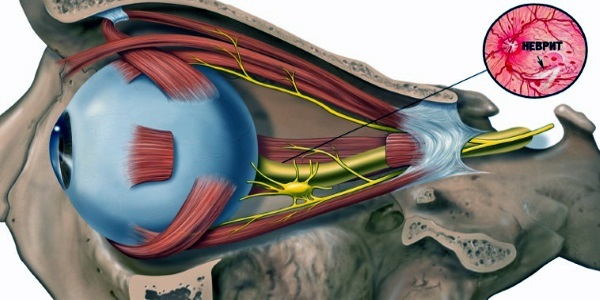
In addition, features such as
- are characteristic for optic neuritis. Strong or aching long pains in the eyeball, which are increasing and increasing as the disease develops. Pain is felt not only during the movement of eyeballs, but also at rest.
- In a patient, twilight vision worsens."Chicken blindness" is one of the characteristic symptoms for neuritis.
- Headaches may occur.
- Sometimes in the morning, dizziness and nausea begin, but very rarely.
- In the center of the field of vision appears a blind spot, or scotoma.
- Vision drops sharply after taking a hot bath or shower, as well as visiting a bath.
- The perception of color is deteriorating.
- Sometimes, with acute inflammation, there is an increased body temperature.
What happens to the nerve, you can see on the following picture:
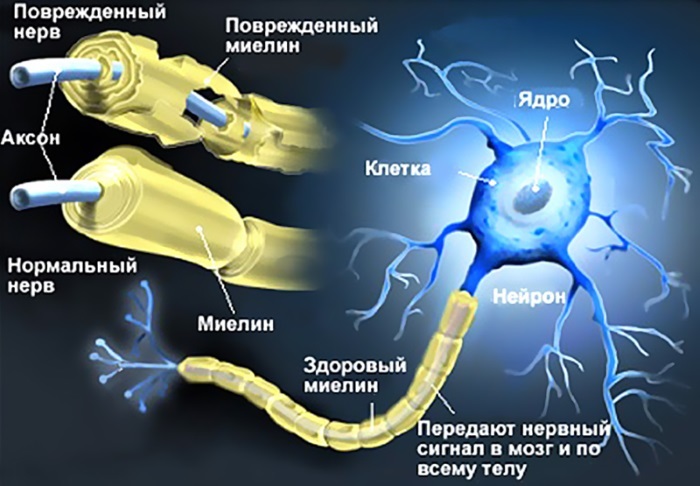
But one symptomatology for the diagnosis is small, so they perform a number of procedures:
- MRI of the brain;
- fluorescent angiography of the fundus;
- examining the eye with an ophthalmoscope and measuring its response to light changes;
- CT of a diseased eye.
In most cases, the diagnosis of neuritis of the optic nerve is not too difficult and does not take much time. But often the disease is discovered late due to the fact that the patient wrote off all the symptoms for manifestations of other, less serious illnesses and did not consult a doctor on time.
Only after an accurate diagnosis has been made, for which it is necessary to consult not only the ophthalmologist, but also the neurologist, treatment can be prescribed.
Treatment of
Treatment for this disease should be immediate and take place in a hospital. At home and especially with traditional medicine, inflammation of the optic nerve can not be cured. Incorrectly selected therapy can even be harmful, often warming up and compresses lead to exacerbation of inflammation and its transition from the nerve to the eyeball tissue.
The inflamed nerve and its normal state can be seen in the following image:
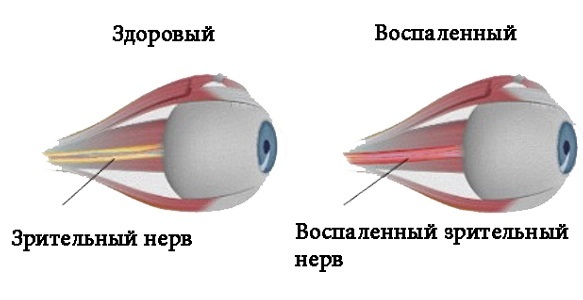
Most often, doctors prescribe medication in the form of a course of antibiotics. When optic neuritis is usually prescribed drugs of a wide range of action, with the exception of aminoglycosides - they negatively affect the organs of hearing and vision. Also, when using neuritis, various anti-inflammatory drugs are used. Both these and other means can have different forms of release, more often they are drops or tablets for oral administration.
In cases when neuritis appeared as a result of the use of methanol, to neutralize the toxin the patient is injected intravenously with ethyl alcohol, and with poisoning - with antidotes. When the cause was autoimmune diseases, the greatest effect is given by the use of corticosteroids. Obligatory are drugs to improve the circulation of blood in the body. The dosage of drugs is chosen by a specialist, as well as the duration of the course of treatment.
In addition, the doctor must prescribe various mineral supplements and vitamins to restore the body during and after the disease.
In severe situations, when drug therapy is ineffective, you have to resort to surgery. The doctor performs decompression, namely - it opens the optic nerve shell, and the pressure, which because of the swelling sharply increases and leads to tissue death, begins to decline very quickly.
If you start treatment on time, the predictions are in most cases positive, the vision returns for several months in full or in part, but since relapses are possible, it is recommended to undergo a preventive examination at least every six months.
Preventive measures
As one knows, one disease often entails another, and the inflammation of the optic nerve can develop as a result of other ailments. In order to reduce the risk of neuritis, must follow several rules:
- to avoid injuries associated with the skull, and in particular - with the eye sockets and the eyes;
- lead a healthy lifestyle, do not take alcohol, especially in large quantities and often;
- in every possible way to strengthen immunity, temper and take a sufficient amount of vitamins;
- is also important for healthy eating and hygiene;
- try not to allow infectious diseases, including - sexually transmitted infections;
- regularly undergo preventive medical examinations.
Forecast
In itself, the disease is not dangerous for the life of the patient. With timely treatment, the prognosis is favorable, however, in cases where the nervous tissue has been severely damaged, partial or complete loss of vision occurs. The optic neuritis caused by autoimmune diseases tends to relapse more than the result of poisoning or infection, and leads to more severe consequences.
Conclusion
In summary, the optic neuritis is as follows:
- Both acute and chronic inflammation of the optic nerve can lead to irreversible blindness.
- This disease very often becomes a companion of severe autoimmune disorders, so when it is found it makes sense to pass tests on the RAS.
- Under no circumstances should you try to get rid of it with folk remedies, in most cases it will be a waste of time or even aggravate the condition of the patient.
- The optic neuritis therapy depends largely on the causes that provoked it.
- In some cases, recurrence of the disease is possible, so people who have transferred it should be shown at least once every six months to the ophthalmologist.
Interesting video
This video might be interested in you:
